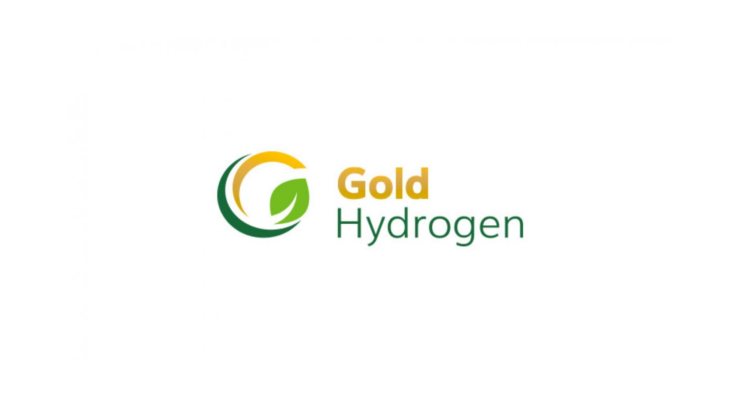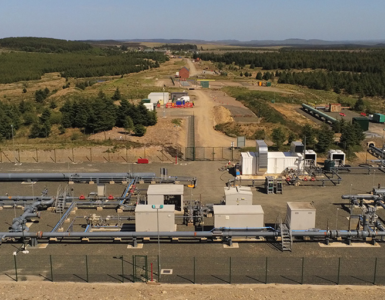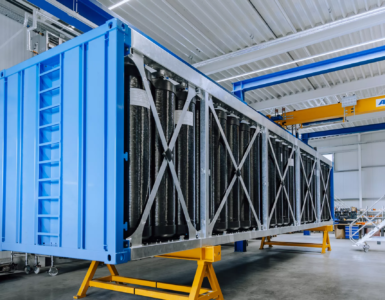Gold hydrogen – significant concentrations of hydrogen and helium detected in the ramsay 1 well.
Further to previous market releases regarding its flagship Ramsay Natural Hydrogen Project, the Directors of Gold Hydrogen Limited (Gold Hydrogen, ASX: GHY, the Company) are pleased to provide further detail on the preliminary results from its Ramsay 1 well.
Drilling operations on the first dedicated natural hydrogen exploration well in Australia, Ramsay 1, were completed on 28 October 2023. The well reached a total depth of 1005m measured depth (MD), and drilled a relatively small section (just over 100m) of the Precambrian basement. The drilling operations were completed within the pre-drill time estimates, under budget and without any HSE incidents. The final well bore was evaluated with a complete set of wireline logs, and with 100% of the rotary sidewall core samples recovered from various depths and formations. The successful completion of drilling operations has demonstrated the capability of Gold Hydrogen and its supporting drilling team to plan and execute Australia’s first dedicated natural hydrogen drilling program.
Whilst drilling through the Parara limestone at 316mMD, a major connected fracture zone was encountered. The presence of wide-spread connected fracture systems within the target formations is essential for the migration of hydrogen from the deeper source to shallow zones from which it can potentially be extracted. Establishing the presence of such a fracture system was a major objective of the drilling of the Ramsay 1 well. However, drilling was impacted when intersecting the fractures due to several instances of drilling fluid losses, and the resulting limited returns made it difficult to monitor and analyse mud gas samples from that point on. The Company will aim to obtain more data on the composition of the gas trapped in the faults and fractures within the hydrogen bearing Parara limestone and other target formations in future wells. The gas sample results received to date from Ramsay 1 are part of an ongoing laboratory analysis program being undertaken on the Company’s behalf at Petrolab Australia Pty Ltd in Adelaide. As well as ongoing analysis of gas samples taken at various depths from Ramsay 1, Petrolab will be involved in testing gas samples from the Ramsay 2 well. Rock chip and side wall cores collected from both wells will ultimately be tested at specialty laboratories.
🔥 What about we co-host a webinar? Let's educate, captivate, and convert the hydrogen economy!
Hydrogen Central is the global go-to online magazine for the hydrogen economy, we can help you host impactful webinars that become a global reference on your topic and are an evergreen source of leads. Click here to request more details
Mud gas samples collected from the levels above the top of fracture zone have shown air-corrected hydrogen levels of up to 73.3%, with the highest level measured from a sample collected from 240mMD. This hydrogen level aligns with the measurement taken while drilling the historic Ramsay Oil Bore 1 in 1931, which recorded an air-corrected hydrogen level of 76% at 240.8m. Multiple other samples returned hydrogen contents at elevated levels. This demonstrates that the measurements taken during the drilling of the historic Ramsay Oil Bore 1 can be replicated with modern drilling processes and confirms there is a hydrogen play present at the location of the Ramsay Natural Hydrogen project.
The stratigraphy encountered by the Ramsay 1 well is in line with the pre-drill predictions, with a thick section of fractured Parara limestones overlaying a regionally consistent dolomitic sequence of the Kulpara formation. Within the Kulpara formation, several additional fracture and fault zones have been identified, and there are indications of zones with vuggy porosity within the highly dolomitised sequences.
The Precambrian basement was covered by a thick weathered zone, and both the weathered as well as the unweathered basement were found to be heavily fractured. Detailed analysis of the wireline logging data is needed to further evaluate the orientation and aperture of the various fracture systems and what level of porosity and permeability has been generated by the weathering process. Further analysis, establishing the basement depth and the reservoir properties associated with the fractures in the basement, is essential for the estimation of the hydrogen and helium resource potential of the regional extensive basement play.
Sampling with the formation testing tool was compromised due to the heavily fractured nature of the zones selected for testing. A sample recovered from the interval at 892mMD was analysed for formation fluid composition, and the associated gas revealed an air-corrected helium content of up to 3.6% with the remainder being nitrogen. This suggests that the basement is generating helium in significant amounts, and that the overlying weathered zone may act as a reservoir retaining the helium in commercial concentrations.
Helium is a valuable and rare commodity, and its unique properties gives it a widespread usage in the medical industry, as well as for scientific research, space exploration, diving and energy industry applications. There is no way to manufacture helium artificially, and its price fluctuates based on global demand and declining supply. Helium currently trades upwards of USD600 / MCF, which is up to 200 times more than LNG.
The results remain preliminary in nature and further ongoing evaluation of the well and sampling data will be required to reduce the remaining uncertainties around the vertical and lateral distribution of the natural hydrogen. However, the Company is pleased that these preliminary results support its ongoing work in discovering Australia’s first natural hydrogen field. Further work is also required to understand the extent of helium within the Ramsay 1 well bore. Well testing is being considered, with a final decision to be made following an analysis of the drilling and sampling results of the Ramsay 2 well.
Gold Hydrogen considers these encouraging results warrant the immediate drilling of Ramsay 2, which is located in close proximity to the Ramsay 1 (refer Figure 1). The technical objectives of Ramsay 2 will be similar to Ramsay 1 in terms of well depth and target formations, and Ramsay 2 is planned to be drilled within the November-December 2023 period.
It is important to note that there remain both geological and potential development risks associated with the Ramsay Project and the Company’s commercial and business objectives. These risks relate to the presence, recovery and potential volumes of hydrogen, but also due to the location of the resource within agricultural areas and the proximity to National Parks on both Yorke Peninsula and Kangaroo Island, requiring significant landholder and community engagement. The worldwide, Federal and South Australian Government and industry efforts to secure hydrogen as an alternative energy source provides confidence that any technical and social concerns may be overcome.

About Gold Hydrogen
Gold Hydrogen is focused on the discovery and development of world class natural hydrogen gas in a potentially extensive natural hydrogen province in South Australia. This region has only recently had its natural hydrogen potential identified by the Company. The domestic and global demand for hydrogen, combined with new natural hydrogen exploration techniques and experienced personnel, provides Gold Hydrogen with an extraordinary opportunity to define and ultimately develop a new natural hydrogen gas province.
The combined natural hydrogen permit area of the Gold Hydrogen group is approximately 75,332km2. Gold Hydrogen holds one granted petroleum exploration license (the Ramsay Project – PEL 687) and its two 100% owned subsidiary companies (White Hydrogen Australia and Byrock Resources) hold an additional seven (7) applications for natural hydrogen exploration within South Australia.
Highlights:
- Significant concentrations of hydrogen and helium have been encountered in sections of the Ramsay 1 well, confirming historic measurement and demonstrating an active hydrogen system in the Ramsay Project area.
- Testing and laboratory results measured air-corrected hydrogen at 73.3% at 240m below ground level, consistent with the 76% air-corrected concentration of hydrogen reported in the Ramsay Oil Bore 1 in 1931. These measurements validate historical results, and confirm the presence of a hydrogen play at shallow depths in the Ramsay Project area.
- A major connected fracture zone was encountered in the Parara limestone, which is key for the migration of hydrogen from deeper sources to shallow zones.
- Helium was also detected with an air-corrected content of 3.6% at 892mMD depth. This is a relatively high concentration of helium which is a rare and valuable resource, and if found in commercial grades and quantities, could be a significant value-add to the Ramsay Project. Globally there are projects producing helium at < 1% due to its high commercial value.
- The Ramsay 1 well was drilled to a depth of 1,005m on time, under budget and with no HSE incidents.
- Following the suspension of the Ramsay 1 well, and whilst drilling and sampling results continue to be analysed and further testing is being considered, the Company is preparing to drill the Ramsay 2 well to further appraise the Ramsay Project’s Prospective Resource (refer Table 2). The Ramsay 2 well is expected to spud in mid-November.
- Managing Director Neil McDonald hailed the test results: “It is incredibly exciting that we have replicated the results of 100 years ago at 240m. With the additional find of helium, which could be a significant value-add to the project, we view these results as being better than planned.”
READ the latest news shaping the hydrogen market at Hydrogen Central
Significant Concentrations of Hydrogen and Helium Detected in the Ramsay 1 Well, October 31, 2023








